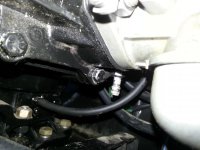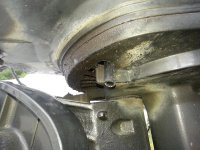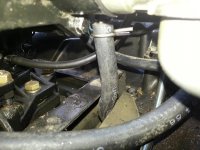Bogging at wot could be something in the tank, the carbs out of sinc, timing off, fuel pump diaphragm bad, primer diaphragm bad and feeding too much fuel at wot, the hoses collapsing from Ethanol, the squeezie bad,(have found them bad right out of the box) the original Force/Chrysler connectors sucking air and more??
Get a can of starting fluid.
Start it and spray the fluid around the engine and see if it makes any difference in the motor running.
Also if there is an exhaust leak(even a small one) it can cause the gaggin at wot.
- we removed the tank and sloshed it with successive liters of gasoline until what we emptied was clear. I also installed a water-separating fuel filter. when I initially primed from dry, the bulb had no problem sucking from the tank through the filter.
- Carbs were *slightly* out of sync, possibly. at least, there was slight tension that seemed to get released when I loosened off the screws.
- have yet to look at the fuel pump and primer diaphragms - will do if the problem persists after the other adjustments.
- Hoses are all new save one - all clamps replaced
- what defines a bad squeezie? mine is new and primes well.
- will try with the starter fluid - have a can for my 54 Fordson Major Diesel
- Exhaust leak from where? What is the best way to go about checking for that?
I checked timing at idle - was 3 or 4 degrees BTDC. I tried checking at cranking with WOT, but could not get a good trigger with all the plugs grounded - will check in the water. I am going to do the synchronize and timing following the instructions I found stickied over at iboats.com (actually I am on step 6 but need to go out to the water to do it and a few subsequent ones). As I was going to sleep last night, I was thinking about that ring getting sheared off in the exhaust port and it dawned on me that the flywheel key may be partially sheared - I will check the timing and if it is out and I cannot dial it in, I will check that.
I also checked compression: 109# top, 118# middle, 118# bottom. I had replaced the middle piston, honed the top and middle cylinders, and did some light 400 grit sanding at 30 to 45 degrees on the bottom cylinder to remove some surface corrosion.
My hope is that after doing the sync, timing, and carb idle setup, it will run fine, or at least run somewhat normal until I get on to regular 50:1 mix
another question: when it was bogging, it did so on acceleration into WOT, not once it reached WOT rpms. I would think fuel supply problems (hose, pump, etc.) would cause bogging after the motor sped up and was using more fuel causing the float bowls to drain, am I correct in my thinking?
- Jeremy






